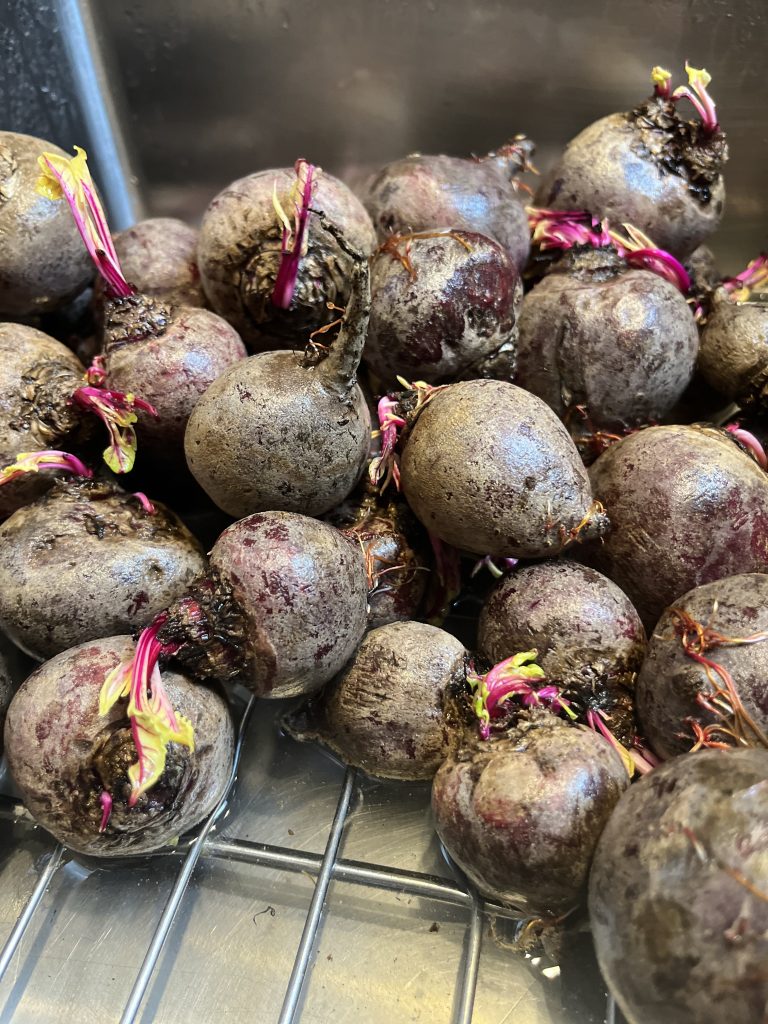So, you find yourself staring at a bunch of beets, wondering what on earth to do with them. Fear not, dear reader, for I am here to guide you through the wardrobe-staining experience of baking beets whole – a culinary adventure.
Selecting and Cleaning the Beets
First things first, let’s pick the perfect beets. You want them to be firm, smooth, and as perky as THOT. Look for ones with their greens still intact, a sign of freshness and vitality. Anything looking sad and droopy should be left on the shelf – we want beets that don’t look beaten. Isn’t that the kind of irony we expect from the world? Trim off those leafy greens, leaving just a little bit of stem to keep the beets from getting too bleedy during their time in the oven.

Or, have you purchased a greenless 20lb bag of beets so small that peeling them seems like the kind of punishment outlawed in some countries? But they’re yours now, Sista!
Once you’ve found your beets, it’s time to give them a good rinse and scrub under cold water. Count, if you can, how many times you disassociate throughout this monotonous task and repeatedly return to find yourself still scrubbing the damned things. (They’re not looking like such a show-stopping deal anymore, are they?)
I digress.
But here’s the thing: the torture ends here. Because you’re going to bake your beets whole, you can skip the agony of peeling! Take this tiny win and throw your beets into a baking dish deep enough to catch potential drips.
Baking Beets Whole
Now, let’s get roasting! Preheat your oven to 375°F (190°C).
If you’ve got a few big, beautiful beets, you might consider wrapping each one in foil like a potato to seal in the moisture as it cooks. If your beets are small, you’ll want to wrap your baking dish in foil to seal all the beets at once. If you want to add a little flavour early in the process, you can dress them with a little olive oil, salt and pepper before wrapping them up. Adding 1 cup of water to the sealed baking dish will help steam the peels and make them easier to remove later.
Bake your beets whole on the middle rack for 45 minutes to an hour and increase time as needed. You’ll know your beets are done when you can slide a knife into them easily. Remove them from the oven and remove the aluminum foil to cool.

Peeling Your Whole Baked Beets
The following should be done with an apron and latex gloves if you’re clumsy and slightly careless, like yours truly. Otherwise, you could emerge from the kitchen looking like you just brutalized someone – but pinker.
Once you can comfortably touch your beets, you can start sliding their skins off with ease. It’s faster and easier than peeling them raw – and you get to keep all your knuckles!
Your beets are now cooked and ready to be used in a soup, salad or pickling brine. And while you could eat your baked beets whole, we recommend slicing them to your preference, depending on the application.
Dressing the Baked Beets Whole
Your beets can be dressed in so many delicious ways! Our favorite is:
- Olive oil (good quality if you can)
- Salt
- Pepper
- Balsamic vinegar
- Spring lettuce mix
- Fresh chopped parsley, dill, basil and chives
- Crumbed feta or soft goat cheese
These are ingredients that can be eyeballed and adjusted to taste. Need more beet salad recommendations? Check out this awesome beet salad dressing blog by the Happy Muncher.
Was it worth it?
Of all the root vegetables in the garden, beets have to be my favorite (with carrots trailing them closely). They are so many varieties to grow and ways to prepare them – and I haven’t yet tried one I didn’t like. There is something so comforting about their sweetness and their beauty that I could easily eat them every day. And I’ll probably have to, because I bought too many beets.

